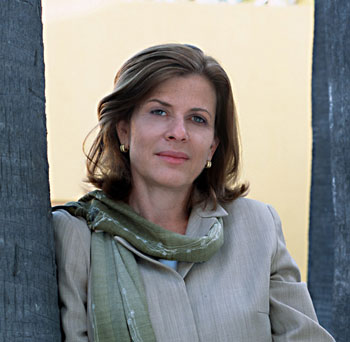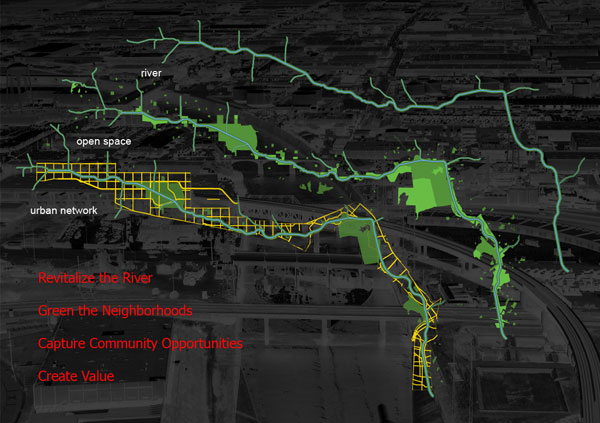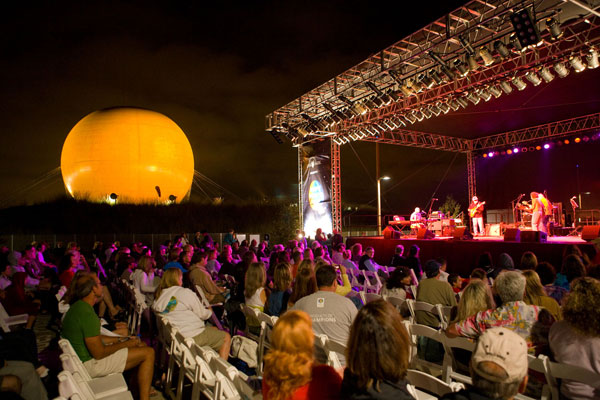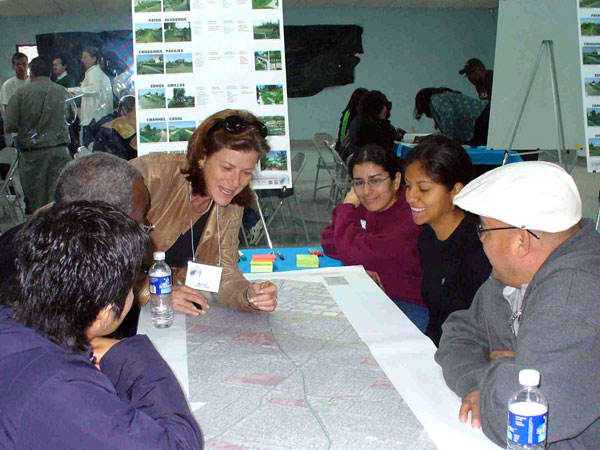News
Interview with Mia Lehrer, FASLA
 Image credit: Mia Lehrer + Associates
Image credit: Mia Lehrer + Associates
Mia Lehrer + Associates often works at the large scale creating master plans that integrate landscape and community infrastructure, creating major public spaces in the process. Why should cities and communities invest in these plans? What are the connections between open spaces and sustainability?
Sustainable communities are about being able to offer people good places to live, jobs, transportation, and education. However, sustainable communities are often communities within communities, because in large cities you're really not creating one community, one place, it's a series of spaces and places and smaller communities. This is especially true when you're building in areas that are repurposed, using land that was originally industrial or commercial. You really have to start thinking of the big picture and how to knit these new developments into the community.
Jeff Speck, co-author of The Smart Growth Manual, argues that it's precisely the lack of planning that results in the "dreck of the suburban sprawlscape." Do you agree that there can never be too much planning if your aim is to create a sustainable community?
I agree with that. It's about planning, but it's really important for there to be good collaboration and communication between public agencies, elected officials, and the private sector so that everybody understands the benefits of these projects. People are starting to understand smart growth, but there's always some mid-level politician or bureaucrat who make things hard to get accomplished. So, it's really important for there to be really good cross-communication.
In a recent interview, Andrea Cochran, FASLA, argues that urban planning needs to be "more adaptable and less prescriptive physically, encouraging adaptation over time. That's a much more innovative approach when you're working on a planning level." On the other side, how do you leave room for adaptation in sustainable community planning?
When you're doing a certain level of planning, you're not getting into the level of detail that allows for adaptation. You have to be thinking of what the possibilities are for the next generation of designers. When you're doing the kind of planning, for example, like we did on the Los Angeles River, you understand that these are big strokes. We were setting forward a vision. We created a series of 20 different typologies, and an approach to urban planning for the project.
You have to take satisfaction that these large-scale planning efforts become a canvas for the next generation of designers. The end goal is not to design every inch of a large-scale project, but to allow for flexibility, educate, and communicate in a healthy way with your clients at these agencies about what the possibilities are.
You recently won an ASLA professional award for the Los Angeles River Revitalization Master Plan, which aims to transform 32 miles of concrete-lined river into public green space, "an ecological and recreational corridor." Please describe the project. Why is it so central to Los Angeles' plans to become a more sustainable, less car-dependent city?
The Los Angeles River Master Plan is 32 miles of a civic piece of infrastructure that has the opportunity to transform the city. It's 32 miles in length, but the sphere of influence on either side of this river ends up being thousands of miles, and involves thousands of streetscapes and potential parks in potential new communities. Economic opportunities relate to new jobs. There's also housing and alternative modes of transportation. People are already using the river, which is just this channel, as a bikeway. We found that people are using it to commute. The river overlay zone has the potential to change the face of the many communities that it traverses -- 32 miles is many communities.
The question is how to break that down into a really effective set of changes, and bring people from their schools and libraries down to the river. Another questoin is how do you actually make the area more connected. How can we use green streets and affect change across the whole overlay zone, not just with signs that say, the river's down there, but actually make it a new kind of space within the city that has a different sense of place. We are proposing to plant thousands and thousands of Sycamore trees there.
The federal mandate is to deal with flood protection and water quality. There are huge fines coming down in the next decade. Starting in 2012, the Federal Government will issue guidelines on water quality, outlining quality standards for the water you're emitting. Anything that eventually goes back to the ocean has to achieve a certain level of water quality. The motivation is to create projects that enable you to clean water, but at the same time provide other benefits. Instead of putting a filter at the end of a pipe, you can actually clean the water through a park with a higher benefit to the community. It's a wonderful large-scale project, an infrastructure project that can have multi-benefits.
 Image credit: Mia Lehrer + Associates
Image credit: Mia Lehrer + Associates
A high speed rail project has been proposed for California. It happens to coincide downtown with areas that are considered very sensitive for the L.A. River. We now have this tension between high speed rail and river benefits. Ideally, there will be an opportunity to make sure these two projects make the best out of the situation. Whatever dollars there are to implement should actually benefit the community. Hopefully, it's not an either/or situation but a plus, plus situation for the city.
You also collaborated closely with Ken Smith, ASLA, on the Orange County Great Park, a massive 1,300 acre park now in development. Most recently, you were involved in the Great Park's Observation Balloon Preview Park, a 27 acre visitor's center. Ken Smith said the park is trying to build a clear connection between sustainable design and healthful, active living. How do you make this connection clear for people in the design?
A project of this scale develops over a long period of time. We are opening up 28-acre sites every year. Every July, we have an opening. The first project was the Observation Balloon, which created areas that allow people to access the site. The site is an old Marine base with a lot of concrete. It's very hot out there in the middle of the summer. We restored an old hangar, the visitor's center, and some visitor servicing facilities, all of which created a destination. We have about 30 concerts and plays and dance performances that happen from May through October and they're very thoughtfully sort of put together.
 Image credit: Mia Lehrer + Associates
Image credit: Mia Lehrer + Associates
When you get to the site, you basically see a 28-acre demonstration garden. We've tested benches, bioswales, low-water use grass, solar-powered garbage cans that actually compact the garbage. Our goal is to create a park that's culturally and environmentally sustainable. It happens to be in the heart of a county and connect the Cleveland National Forest with the Laguna Preserve. It's an incredible opportunity for habitat connection, which we aim to celebrate. Of course, until we can do some of the bigger wildlife corridor connections, which are two and a half miles long, that's going to be a little illusive, but by definition we're recycling an old base and turning it into a healthful sort of new landscape.
We're also celebrating the culture of the place. Agriculture is a very important aspect in that part of the state. We have a community garden that was built this year, and a very active group of community gardeners who actually give classes. We have classes on bee keeping, carrot growing, ethnobotany, and ecology in the community garden under a shade structure. There was a bee keeping class and 200 people showed up. You have to understand this is right in the middle of nowhere, except that there's an energy that's building around the park now.
People watch the balloon go up and down. The balloon is like a large observation tower. People going up and watching the park grow. The idea was to involve the community in the activities, that's part of healthful living. We also have a lot of 5K and 10K runs on the site because it's very navigable. We have had several donations of trees creating a nursery on the site. As of next spring, we are going to be opening up 200 acres of agricultural land, meaning that we're land-banking 200 acres for produce. We've been producing an enormous amount already. We've all ended up with huge bags of onions from just a 10-acre parcel. We are also bringing school groups there and helping young people understand the process of growing food. That's all part of turning the site over, and making sustainability tangible.
You also lecture around the world discussing the public realm of landscape architecture. What have been your experiences in developing world giants like Brazil, India, China? How do their approaches to planning public spaces differ? Which cities or communities are doing the most interesting work in your mind?
The difference between the way other countries do community participatory work is either they don't do it all and it's just a top- down decision. This is what you're getting. Decisions are made at a professional level and there's work involved in convincing people that what you've done is the right thing. In Korea, for example, that's what they do. In South Korea, they get these billion dollar projects built every other day. They're doing three major river projects: $19 billion worth of work in a five year period. It's changing large areas of agricultural land. What they do is is probably really excellent landscape architecture -- it relates to ecology, urban planning, water use, food production, and integrating these. But the outreach is explaining to people why they're proposing to dislocate them from where they lived for 10 generations.
There's a longer history of landscape architects in Brazil. It's probably a more organic and less autocratic process there. There's poverty, but it's not that level of desperation and agglomeration in the urban areas you see in India. It's not the level of intensity. There are favelas, but as chaotic as life in a favela, it's 100 percent better than some of the shanties in India I've studied. So, there's an opportunity to do more.
I'm active in the International Federation of Landscape Architects (IFLA) with whom ASLA should be doing more work and more cross-pollination. It would be a great opportunity for both organizations because they're doing really fabulous work in Brazil and in countries where landscape architecture is barely recognized. They need the support of educators from well-established institutions.
On a very practical level, you interact with a range of stakeholders in all of your projects. What are the key obstacles to achieving community buy-in on projects? What are the usual holdups? What strategies do you use to overcome these challenges?
I see the community outreach as an opportunity to help people understand landscape architecture, understand the process, and what it is we're actually able to do. We can design, but we can't necessarily deliver a project if the funding isn't there. The politicians hold a lot of cards. As we start and educate people about choices, they need to understand that they have a choice between certain kinds of interventions. If it's restoration work, we describe what it will look like so that they are not surprised. If you ask people what they expect their park to look like -- even if we're in an arid climate, everybody always expects Central Park, a verdant oasis with 200 year old trees and a lake. That's not always possible so it's really important to educate people about the realities, which involve economic, environmental, and political factors.
If you ask people what they want and they give you a long list of ideas, it's disingenuous to then leave the workshop and lead them to believe they're going to be able to get everything they ask for. It's about being good listeners because that's part of what we do, but it's also about being clear about what the expectations should be and give them tools to succeed.
 Image credit: Mia Lehrer + Associates
Image credit: Mia Lehrer + Associates
About 99 percent of the time I'm dealing with new immigrants, and they are learning how to communicate and deal with their elected officials. You can embolden people, allow them to feel comfortable that it's their right to communicate, not necessarily demand, but be part of a dialogue. It's education, creating a set of tools, and allowing people to understand they can be advocates for their own needs. However, each project isn't going to be the solution for every one of their problems in the city they live. Many times you'll show up and you'll become a therapist. They'll have a problem, and even though the project might be a park let's say, they'll start talking about how terrible the school is and their housing condition. I think that's an interesting situation.
I'm participating in a series of discussions with a foundation that's starting to figure out how to get involved in urban planning projects and give funding. They're trying to figure out who to give funding to and how and should they get funding for designers. I've been giving this some thought and think that it's really important neighborhood councils actually work at a neighborhood level with these groups to address issues. If there are other people at the table, you can take them on and be more effective.
One of the important things I've learned in community participatory is that allocating enough funds for enough meetings to work through the issues is really important. That's about convincing your client, the agency, or the non-profit, that it's important. There actually has to be time so these people can participate during the planning and construction phases. People need to stay engaged and understand their input is important. That way, they don't become cynical and not participate in the future. Ideally, what you're creating is a constituency that becomes interested in all the projects in their neighborhood. They become community leaders. That's part of a healthy attitude toward your environment and becoming engaged.
I didn't grow up in the U.S. but my parents were community activists. We all don't have a choice but to be engaged and educated about what the dire situation is that we're all in. If we don't have water, we can't use a lot of water. We're going to have parks that don't have a lot of lawns, but that's okay. We're going to find a way of making them beautiful and going to understand why we did that as a group. We're going to turn part of our parks into a community garden and we're going to dedicate the area that might have been some fancy playground into a community garden because we're all going to grow 100 pounds of food a week for ourselves. We're going to find community members who want to participate in the maintenance of the park and the maintenance of the community garden. We're entering a new era.
Mia Lehrer is principal of Mia Lehrer + Associates.
Interview conducted by Jared Green.